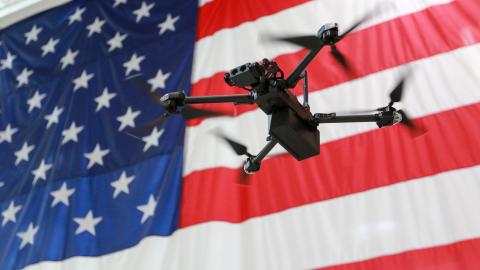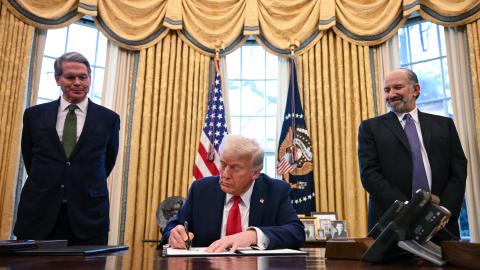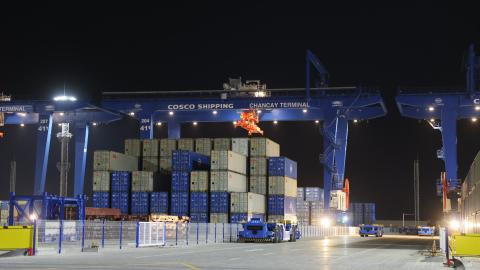Chinese president Xi Jinping on Thursday celebrated the opening of a new port that his state-owned shipping company Cosco has built in the Peruvian fishing village of Chancay.
The opening of the port marks the dawn of a dangerous new era in which China wields its commercial sea power to reshape the international order to Beijing’s design.
China now dominates the construction, financing, and operation of the world’s commercial maritime logistics infrastructure network. China’s dominance spans land and sea, including shipbuilding, ship repair, ship-to-shore crane manufacturing and installation, port design and construction, and the construction of road, rail, warehouse, power and technology networks to manage the system. China amplifies its sea power through a shipping consortium – the Ocean Alliance – whose membership includes shipping lines based in France and Taiwan.
Commercial sea power is the foundation of global supremacy. No country has risen to global supremacy without having relative dominance of the world’s commercial maritime domain. Alarmingly, for the U.S. and the West, no country has long held onto global supremacy after losing the top spot in oceanic commerce and logistics.
Admiral Raymond Spruance, principal architect of the U.S. island-hopping campaign that won the Pacific Theater in World War II, once wrote that “a sound logistic plan is the foundation upon which a war operation should be based.” China has such a plan. The U.S. does not. China is conducting economic warfare against the West, using the containerized logistics system – an American invention – as its weapons platform.
The lead actor in China’s campaign is Cosco. Cosco operates as Beijing’s version of the Dutch East India Company, called the VOC after its name in Dutch. Chartered by the Dutch state to sail to the East Indies and the South China Sea and make treaties, seize territory, raise its own armed forces and secure the lucrative spice trade, the semiconductor chips of that time. In short, the VOC pioneered state capitalism.
Today Cosco spearheads Beijing’s seaborne expansion of Chinese state capitalism. Cosco began investing in Chancay in 2019 with a relatively modest $225 million outlay for a 60% stake in the port manager, Terminales Portuarios Chancay. Cosco’s partner, Peruvian mining company Volcan Compañía Minera holds the remaining share. Demonstrating that Beijing does not let ideology stand in the way of achieving its strategic goals, Cosco and Volcan signed the deal during the World Economic Forum in Davos.
By building a port in Chancay, Cosco did not merely increase trade between Asia and Peru and South America. It connected South America, through Peru, with hard-wired access to the world’s containerized logistics system, the foundation of China’s global power.
Through Cosco and its other port and logistics SOEs, China is surrounding the U.S., methodically occupying logistics sites ever closer to the U.S., using its control of commercial maritime routes to weaken U.S. alliances.
U.S. allies in the Pacific already fear China will use its container shipping power to coerce their political allegiance by restricting supplies, banning non-Chinese ships from loading at Chinese or Chinese-controlled terminals, or imposing outright embargos. One Japanese shipping line recently requested a meeting in Washington to discuss U.S. interest in forming a secure commercial shipping alliance with allied democracies to ensure supplies to civilian populations in the event of conflict with China.
The concept deserves careful consideration. But the U.S. needs to take four more steps to counter China’s commercial sea power. No amount of reshoring of manufacturing will reduce U.S. exposure to Beijing as long as China holds sway over the world’s container logistics network.
Recognizing that time is short, the U.S. should first re-enter the oceanic shipping sector by buying a container shipping line through a suitable structure. Second, the U.S. should bring ports under unified federal management. Ports are national security assets, yet remain under state and local jurisdiction. Federal direction could also address the growing presence of Cosco and its Ocean Alliance partners in American ports. This could include merging some port authorities to increase operational efficiency and reduce costs, perhaps starting with the ports of Los Angeles and Long Beach, an idea that has some traction.
Third, the U.S. should harness private capital for America’s return to the sea by working with Wall Street to create a market for securities designed to attract private sector capital from pension funds to the U.S. led maritime buildup. Many of these funds now invest in diversified infrastructure funds, which can wind up supporting terminals and other assets that benefit China.
Should the new administration realize the urgent need for the position, it should appoint a shipping czar to lead America’s return to the sea. The shipping czar will likely find strong support for vigorous U.S. leadership of a commercial sea power revival that doesn’t stop at the shores of the U.S. mainland.
Time is short. After Xi and Biden meet in Lima, the news cycle will move on. But Cosco will remain, building out the Chinese empire’s newest frontier. Chancay is Cosco’s latest conquest. And unless America responds, it won’t be the last.
Enjoyed this article? Subscribe to Hudson’s newsletters to stay up to date with our latest content.


















